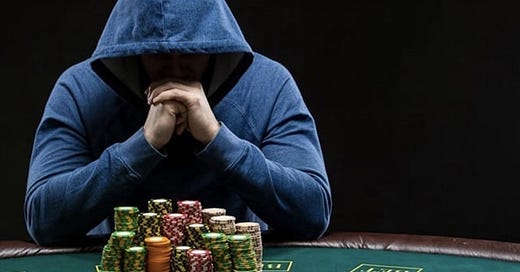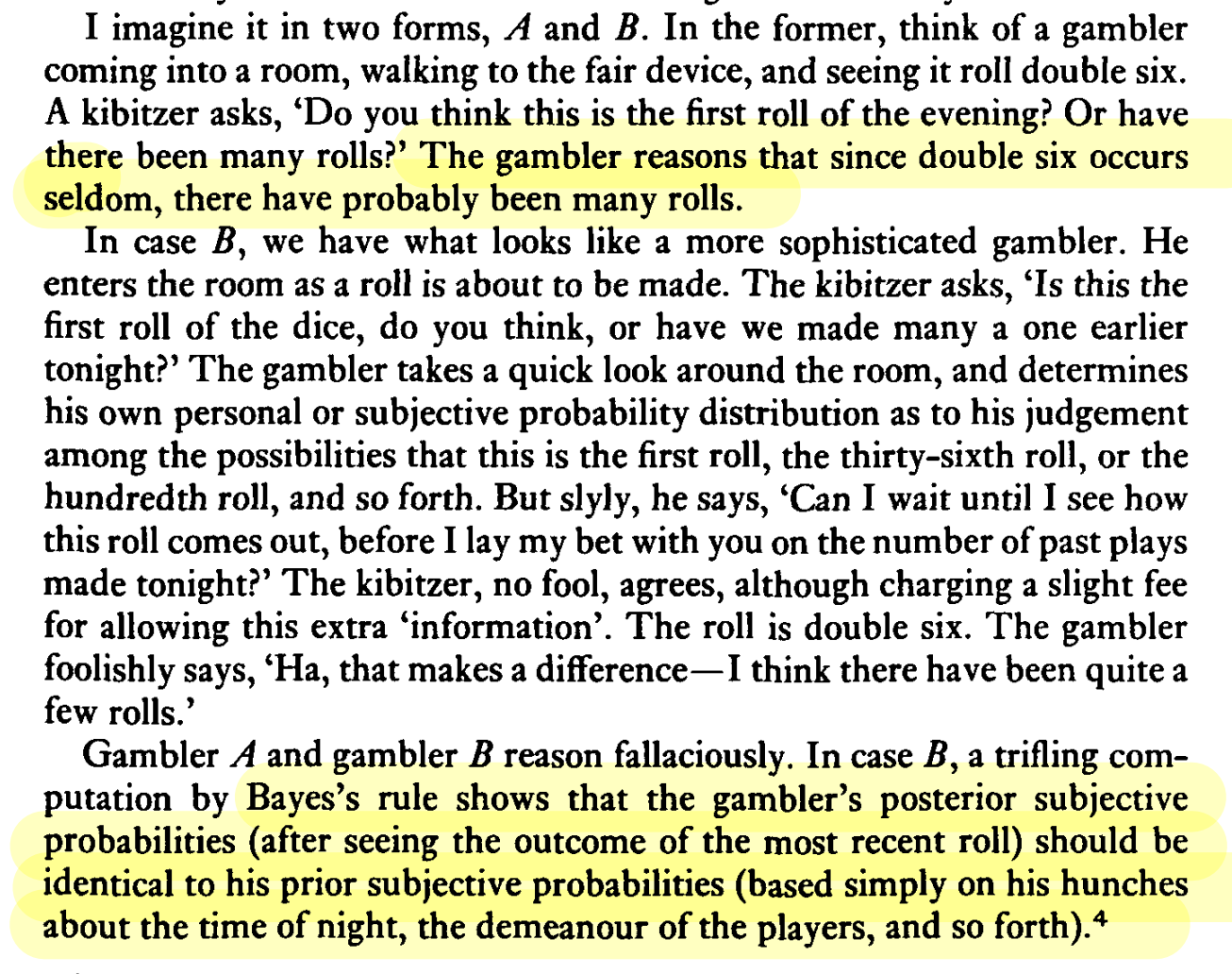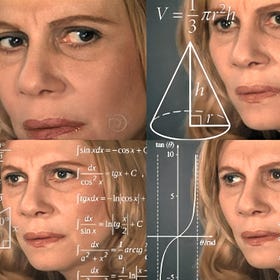Suppose we have some single, seemingly anomalous event and we want to infer something about an explanation of that event using tools from probability theory. What should we infer, and what pitfalls of non-truth-conducive inference might we encounter? One such trap we might fall into is a fallacy of inference named The Inverse Gambler’s Fallacy.
The Inverse Gambler’s Fallacy initially came to my attention through terminally online philosophy of religion discourse, which I am prone to engage with and refer to in these flattering terms. In discussions surrounding fine-tuning, proponents of the fine-tuning arguments infer the existence of God as an explanation of fine-tuning. Some sceptics infer The Multiverse as a “better” explanation instead and thus avoid the conclusion of the argument that God (probably) exists. I first encountered “The Inverse Gambler’s Fallacy” being appealed to by fine-tuning proponents1 who were resisting this sort of objection from multiverse proponents, accusing their inference from fine-tuning to a multiverse as a fallacious one.
Stating my biases here, I don’t buy that fine-tuning is a real explanandum (hence reject both God and Multiverse Hypotheses inferred as explanans). However, I thought that this fallacy talk sounded quite bad, it was something new to me, and I wouldn’t want to be engaging in “fallacious reasoning”; so I embarked to understand the problem.
As for whether or not I believe Multiverse advocates commit this fallacy when they attempt to explain fine-tuning I shall (for now) withhold judgement. In this piece, I hope only to explain some of the main contours of reasoning around The Inverse Gambler’s Fallacy, so that readers might come away with an understanding of what it is and some of the main things to look out for when assessing one’s own reasoning involving inferences of the sort it questions.
The Gambler’s Fallacy
Before explaining The Inverse Gambler’s Fallacy, I shall first introduce the standard Gambler’s Fallacy. The Gambler’s Fallacy is a failure of truth-preserving inference with respect to reasoning about probabilities. I shall first introduce it through a specific case before articulating the general principle.
Suppose Barry the Better is involved in some gambling game involving the rolling of dice. In this game, you place bets about which side you think some fair dice will land on when it gets rolled. Each time the dice is rolled, there are six possible outcomes S (the probability space) = {1, 2, 3, 4, 5, 6}, |S|=6 and any time the dice is rolled we will get one outcome, event e=1, such that the probability of obtaining any one outcome is e/|S| or 1/6 in this case.
Barry the Better has been watching along and he observes the following in the three games that take place before he places his bet. The outcome each time was a 4.
“Ok, 4 came up the previous three times, so that means it probably won’t be a four the next time” reasons Barry. He goes on to place his bet on 5 coming up and loses. We can imagine he goes on placing his bet on 5 over repeated trials thinking it’s more and more likely a 5 will come up because it hasn’t so far done so. He loses each time. How can this happen?
Similarly, we might imagine Barry reasoning “Ok, 4 came up the previous three times, so that means it probably will be a four the next time”. He places his bet on 4 based on this inference and loses.
In both of these cases, we can see Barry making some inference about his observations that provides him with additional information to e/|S| such that he believes the bet he is making has better than a 1/6 chance of coming true. Of course, Barry could have won the bet still (we deliberately stipulated he didn’t in order to make a point), however his inference that he had better knowledge than e/|S| here was wrong.
What went wrong, in both cases, is that Barry made an inference from the outcomes of past trials to future trials in a situation where each trial is probabilistically independent of the other. This means that information about the outcomes of previous trials has no bearing on what we should believe about outcomes in future trials. For each trial, the probability of any outcome is e/|S| regardless of what came before, and that doesn’t change as we roll the dice more.
Admittedly, there is some nuance here. For example, a lot of work is being done by the stipulation in this highly contrived model case of a “fair dice” being rolled, which definitionally means something like a dice which has a propensity to bring about the outcome of any particular side with a probability of 1/6. In a real case, where it was not stipulated that there was a “fair dice” one could be justified in inferring based on (say) a 4 coming up three times in a row, that perhaps this dice is not fair and is rigged to land on a 4. But, for now, simply to introduce The Gambler’s Fallacy, this idealised example will do without getting into the weeds.
The History of Inverse Gambling
The first reference to The Inverse Gambler’s fallacy seems to be Ian Hacking’s 1987 paper2 where he coins the phrase to describe a flawed inference of probabilistic reasoning:
Hacking introduces the fallacy through two thought experiments, A and B. I shall quote the relevant text here and focus primarily on the case he calls ‘A’, but don’t worry too much about these details. I will make each case clearer with some pictures - because science and Truth tell us that picture books are for Sigma males, and overcomplicated notations are for betas3.
Note: ‘Kibbitzer’ is a Yiddish term for a spectator, and yes I had to search the internet for that.
In Case A, we can see the inference being made. This is from the observation of a single outcome to the claim that many outcomes must have happened previously. I am slightly simplifying Case A to the example of a single dice roll rather than a double but all the salient points about probabilistic forms of inference remain the same.
We can slightly formalise the reasoning here might go something like the following - I am presenting this in IBE (Inference to the best explanation) form and I believe this can be translated into ‘Bayesian’ terms too quite easily.
If this is the only time a dice roll event has taken place, then the probability of me observing this is something like e/|S|, so 1/6 and fairly improbable.
However, if an infinite number of dice rolls have taken place previously then seeing this outcome follows as a matter of course.
Therefore, this observation of a 4 being rolled is good evidence that an infinite number of dice rolls have taken place previously.
Hacking uses the language “many” where I use the illustrative example of an infinite number of hypothesised previous events, this is hyperbole to highlight the insane inference being made, however, one could use any example, such as the (selected at random and for no sus’ motive) claim that (say) Beth2 outcomes occurred4.
After reading this far, and seeing that diagram, I suspect, though do not have empirical survey data for this, that many of you (except a select few with gerrymandered intuitions ruined by the worst kind of philosophy) will look at that inference and think something like “that’s very very obviously wrong, we don’t operate in this way, we shouldn’t think this way, that’s just crazy.” I agree, however, I shall exhibit intellectual empathy for those who defend such an inference in order to clarify the problems with this line of reasoning and to (hopefully) persuade these poor individuals, misled by the norms of academic philosophy and its disconnected nature from pragmatic concerns, that there is a better way to think about this that involves rejecting the inference.
Having introduced the fallacy in Cases A and B, Hacking situates it (rightly) as being quite deeply involved in a debate around correct methods of statistical inference and explanation. Articulating the reasons why this form of reasoning should not be considered valid and truth-preserving involves distilling down quite a few complicated concepts into clear summaries. This is a task I shall now undertake.
Explaining The “Inverse” Gamblers Fallacy
Recall that in the case of The Gambler’s Fallacy, the problem with the inference made by Barry the Better was that the information he had available to him did not warrant changing his credence towards the outcomes of future events. The problem in the case of The Inverse Gambler’s Fallacy is similar; the information some agent has available to them does not warrant that agent altering their credences with respect to the probabilities they assign the hypotheses about past outcomes. As Hacking makes clear, there are all sorts of pieces of information that might inferentially justify one forming the belief that many past outcomes of some form have occurred - the contentious claim being examined here is that the observation of this single outcome from a single trial should change ones prior with respect to the probability they assign to the claim that many such trials happened previously.
This diagram is slightly misleading, as there’s a very specific kind of hypothesis that Hacking is claiming is unrelated to our observation of some particular outcome in future trials. That is this:
The relevant kind of hypothesis here is one where there is some kind of stochastic process in trials which generate outcomes where for any given trial, the probability of an outcome is the same independent of past trials and their outcomes. The hypothesis formed is that there must have been many of these trials over time as that increases the probability of me seeing the outcome I see in this trial. The problem with this is that many past trials where this stochastic process happens do not raise the probability of observing any particular outcome now. The probability of a particular outcome for an independent event is fixed for any given trial. My observation of a 4 being rolled now is no more probable conditional on many rolls having occurred previously than if this was the first roll. We can restate this in a more formal way.
M= Many past trials, O= Observed outcome of a trial
The Inverse Gambling reasoning is that Pr( M | O ) > Pr( M ).
The reason this is wrong is because Pr ( M | O ) = Pr( M ). The observation of an outcome from one particular trial of an independent event has no bearing on the prior that there were many past trials. Rolling a dice, whatever the outcome, isn’t information that can tell us how many times previous rolls of the dice were made.
We can show why this must be the case in a more Mathematical way too.
In the case of the roll of the dice Pr( O ) = 1/6.
As this is an independent event, definitionally
Pr( O | M ) = Pr ( O ) = 1/6
Pr( O | ~M ) = Pr( O ) = 1/6
Using Bayes Rule:
Pr ( M | O ) = ( Pr( O | M) * Pr( M ) ) / Pr( O )
= ( (1/6) * Pr( M )) / (1/6)
= Pr( M )
Pr ( ~M | O ) = ( Pr( O | ~M) * Pr( ~M ) ) / Pr( O )
= ( (1/6) * Pr( ~M )) / (1/6)
= Pr( ~M )
That is, in both cases (many previous trials or this being the first trial), the probability of either hypothesis conditional on our new observation of an outcome is just the prior probability. Observing one more independent event has no evidential relation to the hypothesis.
In the abductive version of Inverse Gambler’s reasoning earlier in this article I articulated the chain of inference as:
If this is the only time a dice roll event has taken place, then the probability of me observing this is something like e/|S|, so 1/6 and fairly improbable.
However, if an infinite number of dice rolls have taken place previously then seeing this outcome follows as a matter of course.
We can now see that both of these premises are false. Insofar as we interpret the antecedents of each conditional as Pr( ~M | O ) in (1) and Pr( M | O ) in (2) both conditionals are false. Instead, it is the case that in both cases observation O is equally likely, namely 1/6 in our toy example.
In conclusion, we can now see and understand the fallacy of inference involved in The Gambler’s Fallacy. In real applications of probabilistic inference, disputes about whether or not some line of reasoning falls foul of this fallacy will boil down to identifying whether or not arguments satisfy the following criteria:
The observed outcome is the result of some stochastic process
The probability of an outcome for a trial is the same in any given trial (events are independent)
The hypothesis inferred involves many repeated trials over time
I shall leave it for future articles to explain whether or not I believe we should consider certain controversial particular cases of probabilistic reasoning— such as in Multiverse inferred Fine Tuning arguments or The Anthropic Argument— cases of The Inverse Gambler’s Fallacy. For now, I hope to have cleared up what constitutes the fallacy itself.
Goff, P. (2021). “Our Improbable Existence Is No Evidence for a Multiverse.”,
[https://www.scientificamerican.com/article/our-improbable-existence-is-no-evidence-for-a-multiverse/]
Hacking, I. (1987). “The Inverse Gambler’s Fallacy: The Argument from Design. The Anthropic Principle Applied to Wheeler Universes.”, Mind, 96(383), 331–340. [http://www.jstor.org/stable/2254310]
Philosophy and Rigour
In contemporary Philosophy—particularly the terminally online sort that I am apt to engage with—it is not uncommon to hear words like “prior probability”, “likelihood ratio”, “posterior probability” and “hypothesis” ejaculated as if one had accidentally stumbled into a conference room in some sort of
I am of course being slightly tongue in cheek here as whether or not the claim being made in The Anthropic Argument has relevant features making it susceptible to Inverse Gambler’s Fallacy accusations is up for debate. I shall interrogate this claim in future articles. In the meantime, here is a link to an article which clearly articulates The Anthropic Argument for those interested.













Great article! One very minor thing: in your second calculation showing independence, you forgot “~M” on the right hand side of Bayes’ Theorem in the conditional P(O|~M). I hope that makes sense.